We aint getting no critical technologies from anywhere for any price. Other than whatever we lack, can be learned on our own by getting down to and doing it. This ToT thing is all bakwas.
LCA Tejas: News and Discussions
Re: LCA Tejas: News and Discussions
SAAB's marketing - be it about Gripen or about this GaN AESA Radar system - its just that - Marketing.  Having seen from up close how Volvo claims RM-12 their 'own' engine while what % of it they actually build/what % they know about making an entire engine, and extending the same thing to SAAB and Gripen (I am pretty sure its a valid extension), I really really doubt Indian defence establishment has anything significant to learn from Swedish companies that they cannot themselves learn by doing on their own. There is a thing or two where we can expedite the process using their help, but these things are of no strategic value. Only of tactical nature. SAAB is trying hard to get some business here and there since they are desperate (in my opinion they are struggling to even survive - if it was not defence company it would have been sold by now - that's just my gut feeling though, as a side note). So they are doing what they are doing. But tts funny how many Indians fall for the sweet sweet marketing gimmicks from SAAB and think they will truly give 100% ToT and make us Suppapower-NG in Aerospace. In all probability they might as well ToT of 100% things that they know of. But fact is what the know is perhaps only 20-30% of the whole story.
Having seen from up close how Volvo claims RM-12 their 'own' engine while what % of it they actually build/what % they know about making an entire engine, and extending the same thing to SAAB and Gripen (I am pretty sure its a valid extension), I really really doubt Indian defence establishment has anything significant to learn from Swedish companies that they cannot themselves learn by doing on their own. There is a thing or two where we can expedite the process using their help, but these things are of no strategic value. Only of tactical nature. SAAB is trying hard to get some business here and there since they are desperate (in my opinion they are struggling to even survive - if it was not defence company it would have been sold by now - that's just my gut feeling though, as a side note). So they are doing what they are doing. But tts funny how many Indians fall for the sweet sweet marketing gimmicks from SAAB and think they will truly give 100% ToT and make us Suppapower-NG in Aerospace. In all probability they might as well ToT of 100% things that they know of. But fact is what the know is perhaps only 20-30% of the whole story.
We aint getting no critical technologies from anywhere for any price. Other than whatever we lack, can be learned on our own by getting down to and doing it. This ToT thing is all bakwas.
We aint getting no critical technologies from anywhere for any price. Other than whatever we lack, can be learned on our own by getting down to and doing it. This ToT thing is all bakwas.
Re: LCA Tejas: News and Discussions
I guess dont go for the "full monty" with SAAB/Sweden .. on a case to case basis they could collaborate on the Tejas mark 2 ..AESA for eg., but i feel the Israelis are ahead of the curve by virtue of proximity to the American powerhouses like Raytheon
-
Manish_Sharma
- BRF Oldie
- Posts: 5133
- Joined: 07 Sep 2009 16:17
Re: LCA Tejas: News and Discussions
They are at the most assemblers, bhanu mati type; taking eent and roda to create a humbug like their grippen. Nothing they are creating from ground up, from raw materials, not GaNs not engine nothing.
Putting together and clever softwares we can do better then them, we have already as Tejas is tested in dusty warm aircraft unfriendly environment like ours, while grippen is tested in dustless friendly cold environment of scandinavia.
Also swedes can sabotage from inside as late supplying of radar OR accusing HAL of incompetence unable to absorb their tech. Remember Tejas is a direct threat to their jet.

Best is to leak the story that we we're very near to creating a super-duper GaN chip and see usa france uk all lining up to sell ....
Putting together and clever softwares we can do better then them, we have already as Tejas is tested in dusty warm aircraft unfriendly environment like ours, while grippen is tested in dustless friendly cold environment of scandinavia.
Also swedes can sabotage from inside as late supplying of radar OR accusing HAL of incompetence unable to absorb their tech. Remember Tejas is a direct threat to their jet.
Best is to leak the story that we we're very near to creating a super-duper GaN chip and see usa france uk all lining up to sell ....
Re: LCA Tejas: News and Discussions
Thanks for sharing Karan. Great article, with a lot of interesting material. It's also available in a video or PDF format:Karan M wrote:A beautiful article on the LAVI and how its developed.
http://john-golan.blogspot.in/2016/05/l ... ctive.html
Wish ADA works closely with IAF to similarly shape the next shape of IAFs need
http://john-golan.blogspot.com/2016/05/ ... d-pdf.html
The internet article is itself a sampling from the book on the same subject (although it also adds some new illustrations not available in the book).
https://www.amazon.com/gp/product/1612347223
Re: LCA Tejas: News and Discussions
Both are equally well resources. Israel, because of local demand have a need for end-end capability. Sweden and particularly SAAB became an integrator because that was what they could sustain. Erricson had it existed independently would have tried their best to maintain that end to end capability but for GaN subsystems, SAAB does not plan to have its own foundry (EVER). SAAB has also been very closely tied with US radar OEM's but they choose to work with commercial GaN suppliers (such as Cree in the US). One disadvantage is that they can only source what is commercially available. This is why Raytheon shipped over an AESA antenna to them because Raytheon had a HOT GaAs T/R module production line (X-Band) by 2001 while nothing of that nature was available commercially. SAAB would need to source from German and UK suppliers if they want to avoid their traditional US supplier base for the GaN components for this radar upgrade program.kit wrote:I guess dont go for the "full monty" with SAAB/Sweden .. on a case to case basis they could collaborate on the Tejas mark 2 ..AESA for eg., but i feel the Israelis are ahead of the curve by virtue of proximity to the American powerhouses like Raytheon
One thing SAAB does well is integration. You have it spot on. Their PR is trying to spin this as if this is something of a breakthrough and sets them apart, while in reality it is a mere continuation of what began in 2002 with NORA Phase I when they reached out to Raytheon to supply an AESA antenna for their M-SCAN radar. In 2016, commercial X-band components allow them to create a new antenna based on commercially available stuff. Thats the only real difference. The back end is still a progression from NORA (which may not be a bad thing but needs to be put in context). They can obviously not provide TOT for stuff they don't own but naturally their marketing is going to ignore thatSAAB's marketing - be it about Gripen or about this GaN AESA Radar system - its just that - Marketing.Having seen from up close how Volvo claims RM-12 their 'own' engine while what % of it they actually build/what % they know about making an entire engine, and extending the same thing to SAAB and Gripen (I am pretty sure its a valid extension), I really really doubt Indian defence establishment has anything significant to learn from Swedish companies that they cannot themselves learn by doing on their own. There is a thing or two where we can expedite the process using their help, but these things are of no strategic value. Only of tactical nature. SAAB is trying hard to get some business here and there since they are desperate (in my opinion they are struggling to even survive - if it was not defence company it would have been sold by now - that's just my gut feeling though, as a side note). So they are doing what they are doing. But tts funny how many Indians fall for the sweet sweet marketing gimmicks from SAAB and think they will truly give 100% ToT and make us Suppapower-NG in Aerospace. In all probability they might as well ToT of 100% things that they know of. But fact is what the know is perhaps only 20-30% of the whole story.
We aint getting no critical technologies from anywhere for any price. Other than whatever we lack, can be learned on our own by getting down to and doing it. This ToT thing is all bakers.
Re: LCA Tejas: News and Discussions
where would LCA go for the additional power required for GaN (ten? times more than GaAs)?
LRDE might be already working on this. We don't need any SAAB having deep relationship with bade-saab (jackal & hyde) showing designer puppies to our babies.
LRDE might be already working on this. We don't need any SAAB having deep relationship with bade-saab (jackal & hyde) showing designer puppies to our babies.
Re: LCA Tejas: News and Discussions
AFAIK, the design phase of AMCA is nearing completion. By the time AMCA prototype is to be developed which will take atleast 5+ years we will need an advanced radar for it and by that time it will have to be a GaN one as the contemporary world by then would have established it as a norm.
For India to develop that in such a short timeframe doesn't look possible. India has to get this GaN tech with TOT from US or Japan foundries. With the curent goodwill wave between US, Japan and India (thanks to Chini guys) we have better chances of getting this tech wit TOT from them.
Ofcourse we will have to pay exhorbidant money through our nose for that but we need it badly to be superior to Pakis and Chinis. It is the need of the hour (along with Jet engines). It will also require high level govt. to govt. diplomacy as well.
Also just getting 'GaN tech' or 'the tech to make the GaN tech' is not enough. A radar has to be developed around these techs by integrating all the different modules and antenaes. And then all the components have to be miniaturised. We will need the experience of a foreign OEM for this and now is a right time to start looking for one.
The SAAB knows this and hence the offer for TOT. We should still be very carefull about partnering with them and have a watertight contract that benefits us with clearly spelled out terms of complete TOT and penalties, if otherwise.
The DM said India is looking for a twin engined fighter for IAF for which it is looking for a foreign OEM to partner through Make in India policy. The Elta radar for Tejas can be used on it till the GaN AESA is developed. The GaA based Uttam AESA radar is already making good progress. It will soon be tested and ported to Tejas. This can also be used on the interim on the new twin engine fighter.
I am of the opinion that Gripen-E may have a cannibalising effect on Tejas. And hence we must go only for a partnership for GaN Radar with SAAb or any other foreign OEMs.
Tejas needs to be a competitive product in the market.
Also I fail to understand what is so difficult in manufacturing actuators? Why are Indian defence OEMs not able to crack this tech. Certainly it will not be as difficult as making radars. Can someone please shed some light on this...
For India to develop that in such a short timeframe doesn't look possible. India has to get this GaN tech with TOT from US or Japan foundries. With the curent goodwill wave between US, Japan and India (thanks to Chini guys) we have better chances of getting this tech wit TOT from them.
Ofcourse we will have to pay exhorbidant money through our nose for that but we need it badly to be superior to Pakis and Chinis. It is the need of the hour (along with Jet engines). It will also require high level govt. to govt. diplomacy as well.
Also just getting 'GaN tech' or 'the tech to make the GaN tech' is not enough. A radar has to be developed around these techs by integrating all the different modules and antenaes. And then all the components have to be miniaturised. We will need the experience of a foreign OEM for this and now is a right time to start looking for one.
The SAAB knows this and hence the offer for TOT. We should still be very carefull about partnering with them and have a watertight contract that benefits us with clearly spelled out terms of complete TOT and penalties, if otherwise.
The DM said India is looking for a twin engined fighter for IAF for which it is looking for a foreign OEM to partner through Make in India policy. The Elta radar for Tejas can be used on it till the GaN AESA is developed. The GaA based Uttam AESA radar is already making good progress. It will soon be tested and ported to Tejas. This can also be used on the interim on the new twin engine fighter.
I am of the opinion that Gripen-E may have a cannibalising effect on Tejas. And hence we must go only for a partnership for GaN Radar with SAAb or any other foreign OEMs.
Tejas needs to be a competitive product in the market.
Also I fail to understand what is so difficult in manufacturing actuators? Why are Indian defence OEMs not able to crack this tech. Certainly it will not be as difficult as making radars. Can someone please shed some light on this...
Re: LCA Tejas: News and Discussions
^^^ I had similar thoughts. This GaN AESA tech RFI would be more for FGFA and AMCA developments and not for Tejas. But that is just my thinking and no evidence to suggest this.
I also think and agree with some above that the offer is available because
a) We are close to developing our own UTTAM AESA and
b) Present geo-political alignments.
I also think and agree with some above that the offer is available because
a) We are close to developing our own UTTAM AESA and
b) Present geo-political alignments.
Re: LCA Tejas: News and Discussions
for a fist full of dollars more we would have had EJ200s rather GE414s. It is just not politics alone, but certain aspects that fails logical analysts go tipsy! but having gone GE it is not worth to keep switching core components (especially the hearty engine) and so are other niche components like radar systems, unless it is all home grown replacements.
I guess it is better to continue with GE and Elta respectively. Elta can also work with us on GaN
I guess it is better to continue with GE and Elta respectively. Elta can also work with us on GaN
Re: LCA Tejas: News and Discussions
Some nice pictures from Bahrain.

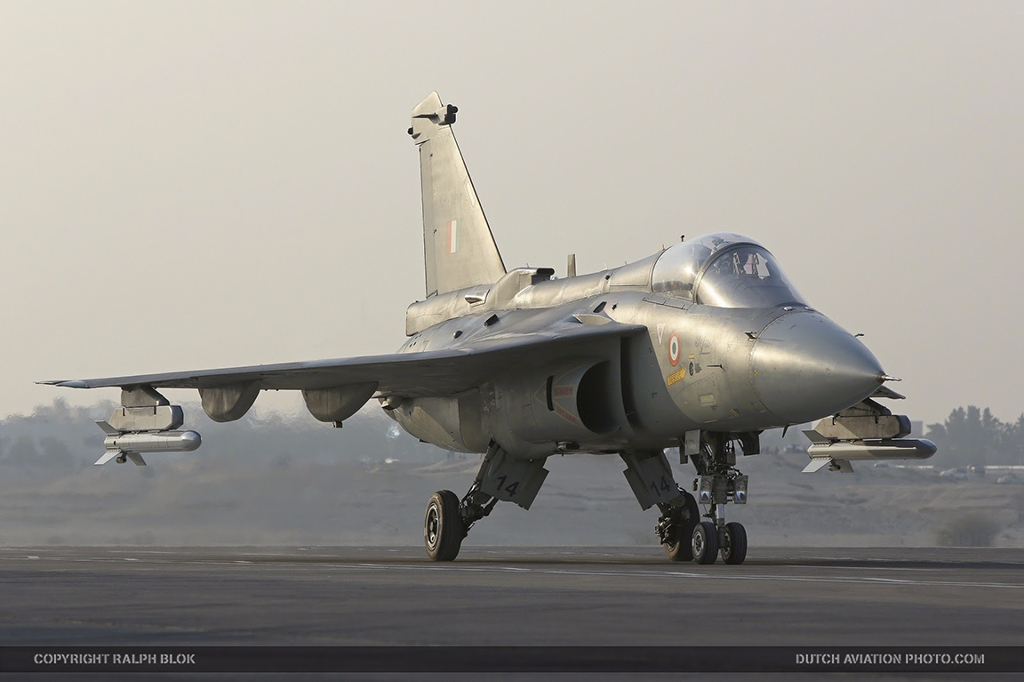
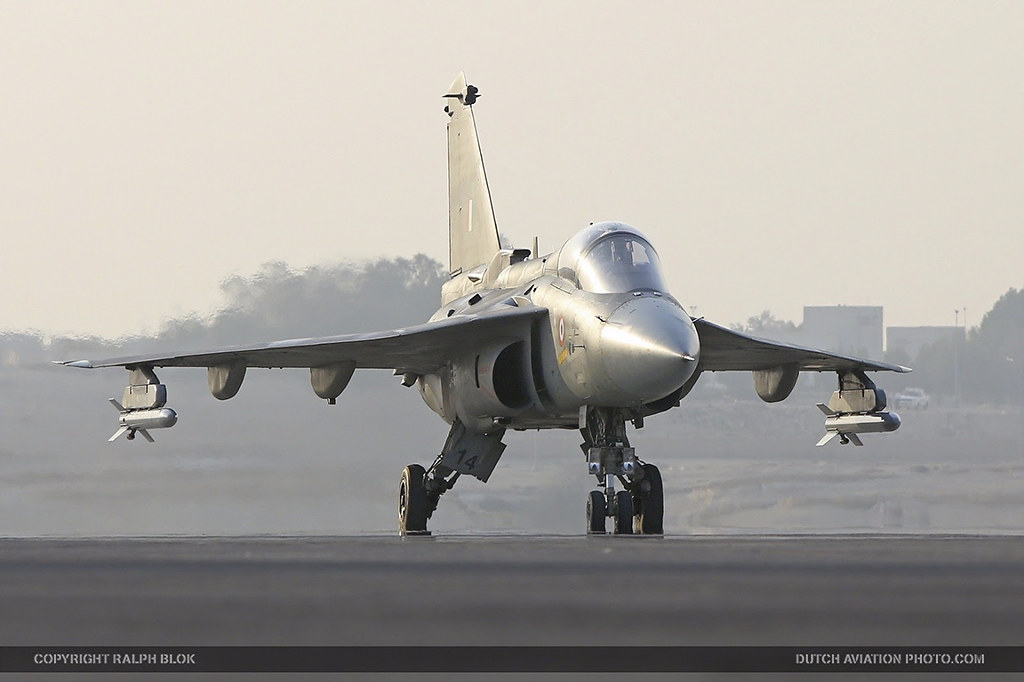
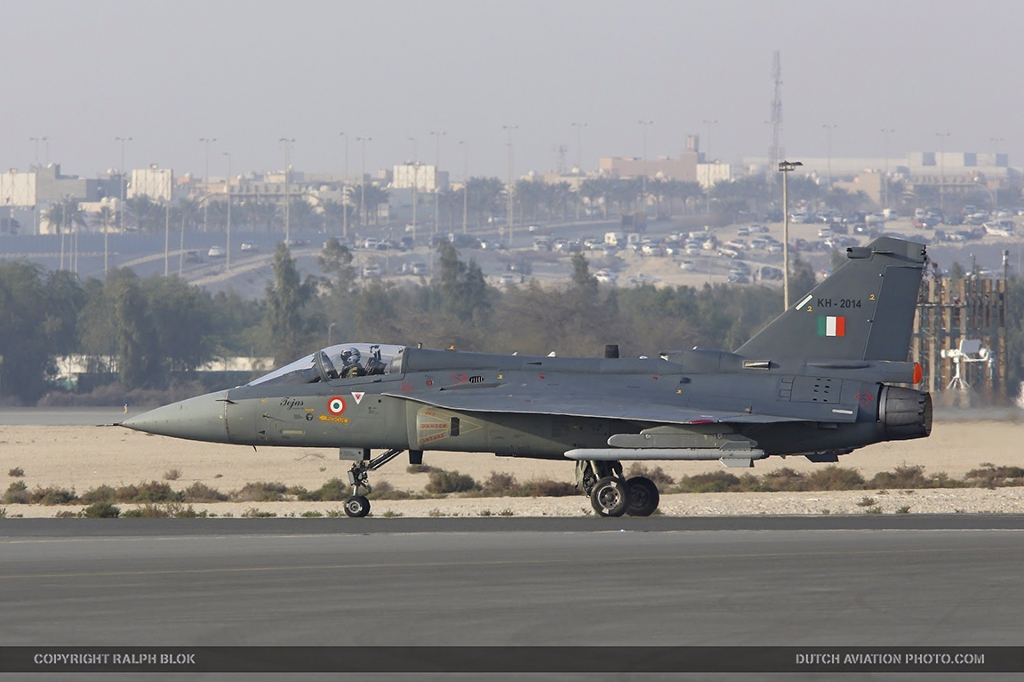

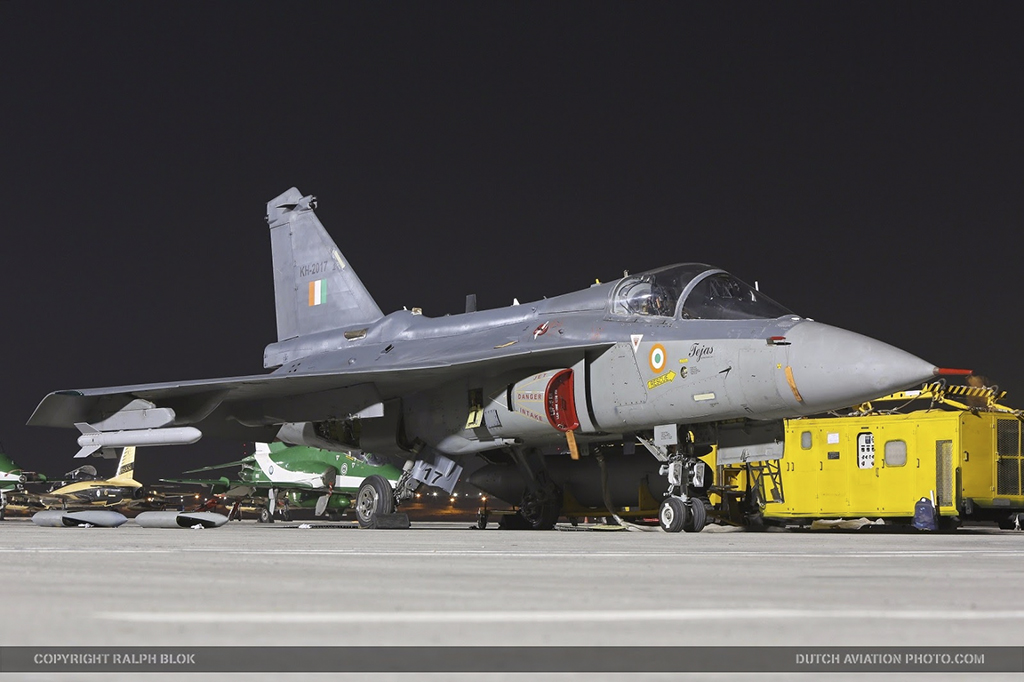
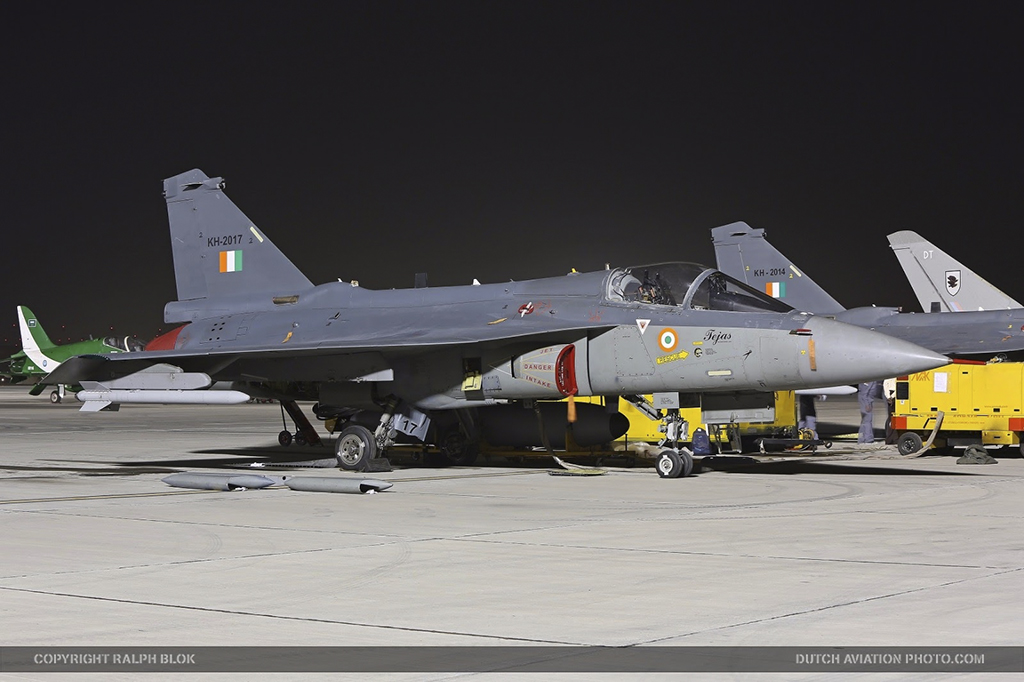
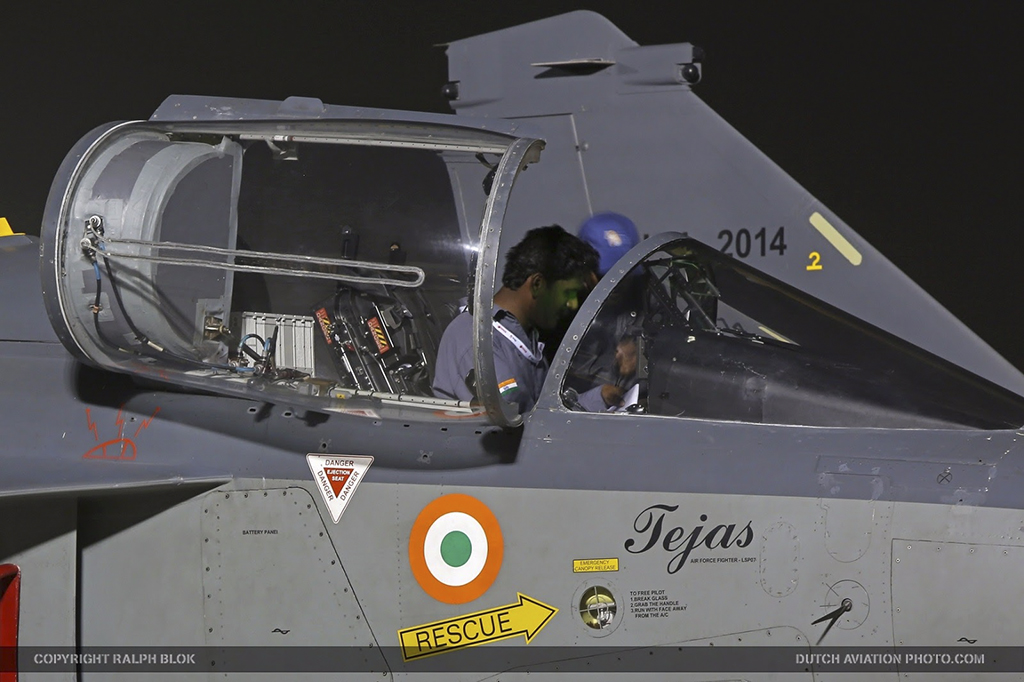
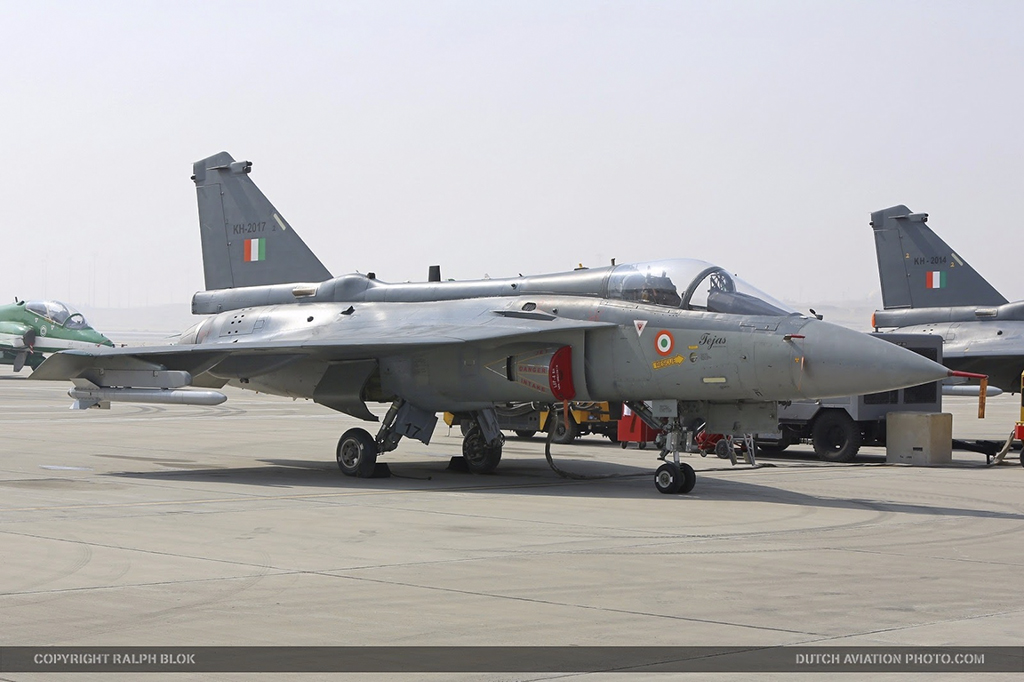
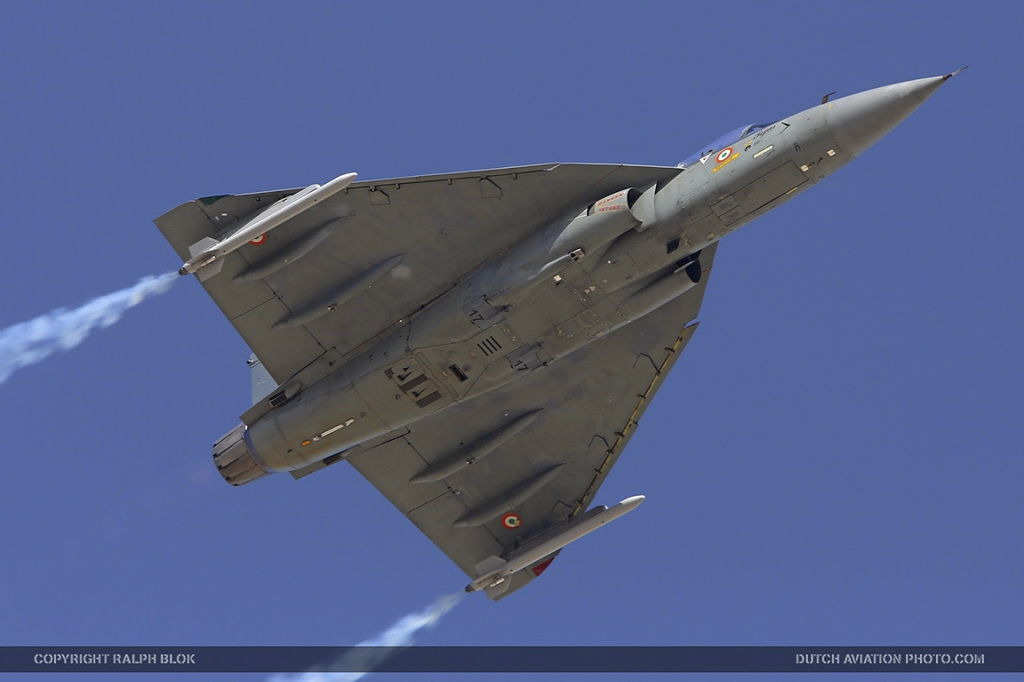
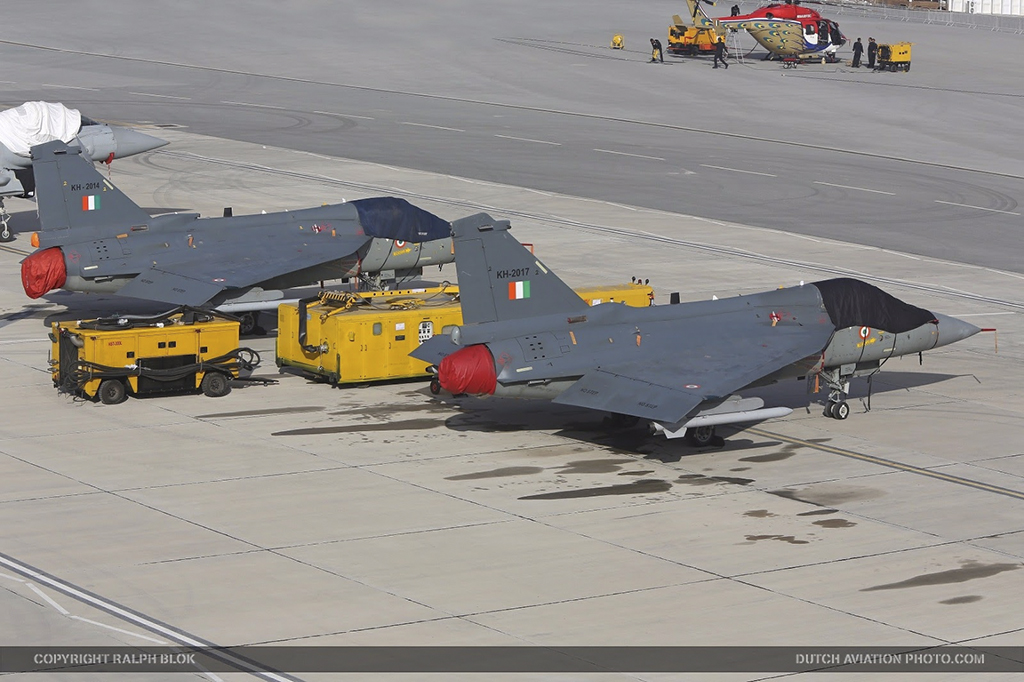
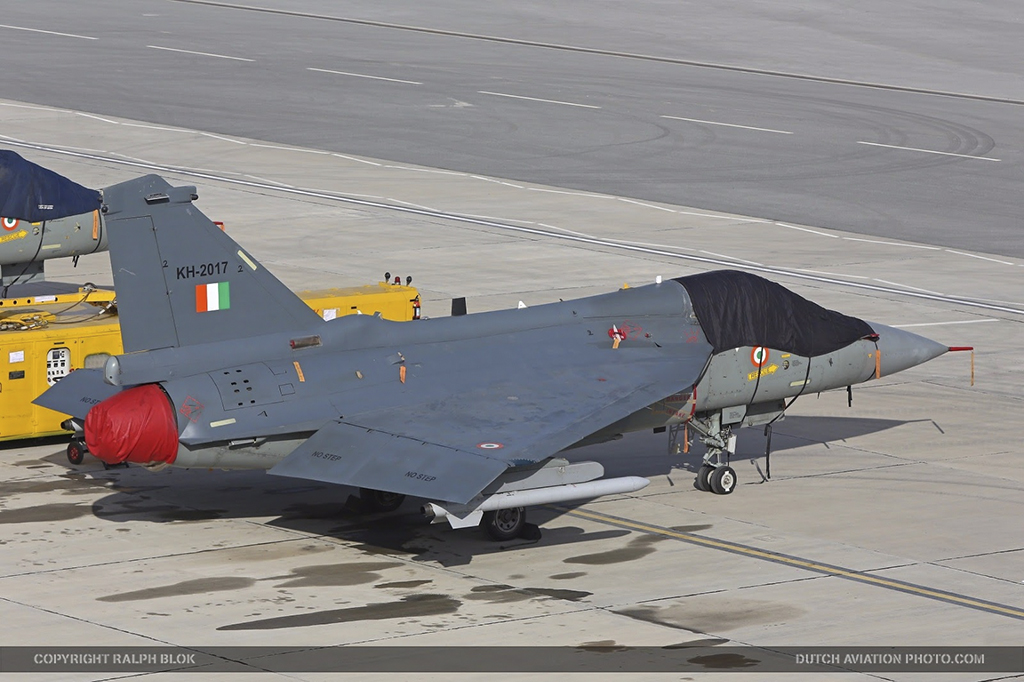
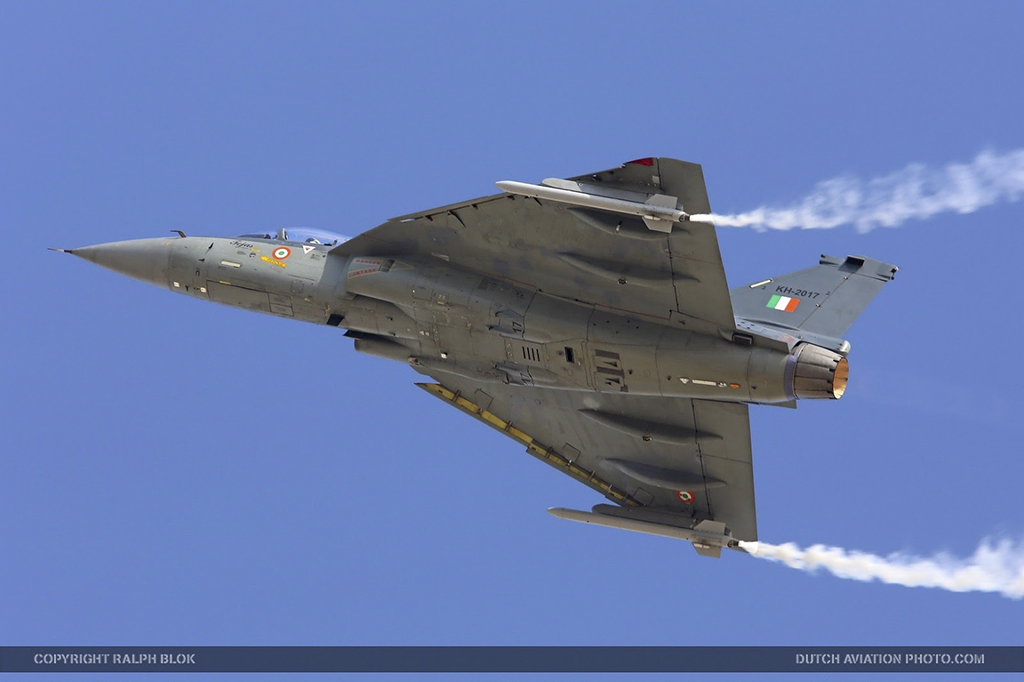













Re: LCA Tejas: News and Discussions
Suddenly its looking Bigger and Better ( pun intended)
Re: LCA Tejas: News and Discussions
Can't wait to see a squadron tarmac pic.. that grey looks naice in the LCA.
Great shots.. warmed the cockles of this jingo
Great shots.. warmed the cockles of this jingo
Re: LCA Tejas: News and Discussions
Clear blue skies, bright sunlight and low air pollution and we can see just how nice looking the lca is.
Re: LCA Tejas: News and Discussions
I think its a very cute plane ... It needs to be made menacing ...
Well though we all have a soft corner for it and wish it the BEST, lets be honest here .... It is not one of the best lookers out there ...
And its not the plane , its the constant disregard for aesthetics in design all across the Indian manufacturing and designing sector ... On the other hand the design was frozen almost 15 years ago ...
Lets hope the AMCA and the new twin engine fighter will get some menacing futuristic looks ...
Also whats this crap I hear about the LM F-16 being developed in India ???
Thats Blasphamous ...
...
Well though we all have a soft corner for it and wish it the BEST, lets be honest here .... It is not one of the best lookers out there ...
And its not the plane , its the constant disregard for aesthetics in design all across the Indian manufacturing and designing sector ... On the other hand the design was frozen almost 15 years ago ...
Lets hope the AMCA and the new twin engine fighter will get some menacing futuristic looks ...
Also whats this crap I hear about the LM F-16 being developed in India ???
Thats Blasphamous
Re: LCA Tejas: News and Discussions
Why dont you go ahead and add some claws or sawn off shotguns or may be angry tiger eyes to make it menacing ? 
Re: LCA Tejas: News and Discussions
Man, that build quality in the second pic...drool worthy stuff!
Re: LCA Tejas: News and Discussions
It is very clear that the designers had their head and heart to make a top class plane, and not, since this is a first one, so let us get it out somehow attitude.
Re: LCA Tejas: News and Discussions
Re build quality .. can clearly see the smoothing attempted at the air intake vent near the dorsal spine in the Kh2014 and KH2017 in the pic where they are parked side by side... So incremental changes but significant because this is our baby..!!
Re: LCA Tejas: News and Discussions
Hahaha ... were u one of the designing team members ...?jamwal wrote:Why dont you go ahead and add some claws or sawn off shotguns or may be angry tiger eyes to make it menacing ?
@Jayram, Totally agree on the build quality and smooth curves , especially over the wing fuselage ...
I guess the composites helped avoid too many rivets on the body ... Really good build for a first attempt ...
Re: LCA Tejas: News and Discussions
It's great finish period. Why minimize it by saying first attempt..NachiketM wrote:jamwal wrote: I guess the composites helped avoid too many rivets on the body ... Really good build for a first attempt ...
Re: LCA Tejas: News and Discussions
I am not sure if your post is in jest.NachiketM wrote:I think its a very cute plane ... It needs to be made menacing ...
Well though we all have a soft corner for it and wish it the BEST, lets be honest here .... It is not one of the best lookers out there ...
And its not the plane , its the constant disregard for aesthetics in design all across the Indian manufacturing and designing sector ... On the other hand the design was frozen almost 15 years ago ...
Lets hope the AMCA and the new twin engine fighter will get some menacing futuristic looks ...
Also whats this crap I hear about the LM F-16 being developed in India ???
Thats Blasphamous...
If it is then ignore my post
else
What if the ditsy looking Tejas with its composite frame and sleeky meeky looks evades the Pakistani F-16 radar Search mode and finishes the Solah.
Did the menancing looks and the painting help ? Or was it the Brains of the Lungi Wearing Saaath Indian that augmented the Naaarth Indian's Piloting skills in giving the Tejas's its first F-16 Kill. (Khalsa undertakes his lungi dance, Balle Balle !!)
While I agree with comments where we can see the poor quality steel finish and poor layout of structural materials.
I cast my doubt on the menancing futuristic looks part you propose.
Have a look at the Futuristic Fanboy art around the Pak-FA before it was revealed..... its so so so different than the real deal.
yet one is a JPEG and other is a real aircraft taking off on daily testing flights.
Happy BRaving Nachiket
Remember
An inspection ready Unit Never Passed Combat
A Combat Ready Unit Never passed Inspection.
Re: LCA Tejas: News and Discussions
Hey ... No offence Khalsa ...
If you read any of my previous post you will see that I am all for Tejas ... Have no doubt that my support is unwavering... I am not critisizing the plane but the aesthetic sense of the designers ... A little more effort there wont hurt, would it?
After all jo dikhta hai woh bikta hai ...
It is just that having an excellent product is not enough... it needs to be packaged well too... Its called 'In pursuit of excellence'. We are going to market this product to the world, aren't we?
Tejas is and will remain an excellent product... Its a symbol of Indian ingenuity and resilience... And I totally agree with your focus on its functionality...
Having said that I respect your opinion and would fight for you to have you express it, just as I would fight for myself to express mine...
A little critical feedback about Tejas shouldn't hurt anybody's feelings, me thinks ...
Tejas is as much my baby as it is yours ...
Peace out...
If you read any of my previous post you will see that I am all for Tejas ... Have no doubt that my support is unwavering... I am not critisizing the plane but the aesthetic sense of the designers ... A little more effort there wont hurt, would it?
After all jo dikhta hai woh bikta hai ...
It is just that having an excellent product is not enough... it needs to be packaged well too... Its called 'In pursuit of excellence'. We are going to market this product to the world, aren't we?
Tejas is and will remain an excellent product... Its a symbol of Indian ingenuity and resilience... And I totally agree with your focus on its functionality...
Having said that I respect your opinion and would fight for you to have you express it, just as I would fight for myself to express mine...
A little critical feedback about Tejas shouldn't hurt anybody's feelings, me thinks ...
Tejas is as much my baby as it is yours ...
Peace out...
Re: LCA Tejas: News and Discussions
Well, Its OK to make opinions but we should not make matters sound trivial in our jingoism. It applies to me as much as to you or for that matter any other jingo.NachiketM wrote:Hey ... No offence Khalsa ...
If you read any of my previous post you will see that I am all for Tejas ... Have no doubt that my support is unwavering... I am not critisizing the plane but the aesthetic sense of the designers ... A little more effort there wont hurt, would it?
After all jo dikhta hai woh bikta hai ...
It is just that having an excellent product is not enough... it needs to be packaged well too... Its called 'In pursuit of excellence'. We are going to market this product to the world, aren't we?
Tejas is and will remain an excellent product... Its a symbol of Indian ingenuity and resilience... And I totally agree with your focus on its functionality...
Having said that I respect your opinion and would fight for you to have you express it, just as I would fight for myself to express mine...
A little critical feedback about Tejas shouldn't hurt anybody's feelings, me thinks ...
Tejas is as much my baby as it is yours ...
Peace out...
Fit and finish is not just the issue with Designers' intentions or mindset or priorities. Its the issue related to your manufacturing capabilities and resources you have at your disposal. The designer has to balance a design with respect to the manufacturing processes and their capabilities and the cost of manufacturing. Neither it is so simple matter. Higher the finish you want, tighter would be the tolerance requirements, more demanding the manufacturing processes are. Cost and machine time increase exponentially with every bit of extra tight tolerances you apply. According to what I have heard from insiders, one of the reasons for the failure (wrt LCA) for Kaveri was unrealistic tolerances that design team had specified without thinking what we can actually manufacture or even sometimes neglecting common sense (like not rounding off numbers). Another point in consideration is that the composite manufacturing processes are invented from scratch for LCA. They are still not fully industrialised (will only happen with scale and time). Our next iteration will be far better.
Re: LCA Tejas: News and Discussions
Hasn't the number of rivets gone way way down in the recent air frames?
https://pbs.twimg.com/media/ClnBdCSXEAEgzud.jpg:large
https://pbs.twimg.com/media/ClnBdCSXEAEgzud.jpg:large
-
sanjaykumar
- BRF Oldie
- Posts: 6712
- Joined: 16 Oct 2005 05:51
Re: LCA Tejas: News and Discussions
For what it's worth, I am sensitive to bad design. I think the Tejas looks just fine.
Re: LCA Tejas: News and Discussions
Absolutely Nilesh... As I said earlier functionality is paramount ... hope the next iteration would be better...nileshjr wrote: Well, Its OK to make opinions but we should not make matters sound trivial in our jingoism. It applies to me as much as to you or for that matter any other jingo.
Fit and finish is not just the issue with Designers' intentions or mindset or priorities. Its the issue related to your manufacturing capabilities and resources you have at your disposal. The designer has to balance a design with respect to the manufacturing processes and their capabilities and the cost of manufacturing. Neither it is so simple matter. Higher the finish you want, tighter would be the tolerance requirements, more demanding the manufacturing processes are. Cost and machine time increase exponentially with every bit of extra tight tolerances you apply. According to what I have heard from insiders, one of the reasons for the failure (wrt LCA) for Kaveri was unrealistic tolerances that design team had specified without thinking what we can actually manufacture or even sometimes neglecting common sense (like not rounding off numbers). Another point in consideration is that the composite manufacturing processes are invented from scratch for LCA. They are still not fully industrialised (will only happen with scale and time). Our next iteration will be far better.I love how nice and shiny F-22 or F-35 or Rafale looks. Looks are a way of making statement - about your capabilities and as a psy-ops. Jets do have functional need of fit and finish - they are not for show off only. But it should not come at exorbitant time/cost as well, nor supersede the more important functional requirements. If it can be kept simple, a designer should keep it simple to save resources.
It is not my attempt to trivialise anything related to hardwork put in by our Scientists and Engineers, afterall they are there for a reason and geniouses in there own fields... Thats why I wrote in an earlier post that "Tejas is and will remain an excellent product... Its a symbol of Indian ingenuity and resilience... And I totally agree with your focus on its functionality..."
Also I had asked earlier why is it so difficult to make quality actuators that we have to source them from other countries?
Can anyone please share their knowledge about actuator tech?
Re: LCA Tejas: News and Discussions
For all the BRFite's drooling over LCA., wait until NLCA gets the F-414. It already has the curves, the attitude and soon will have the power. It definitely has great 'legs'  .
.
Re: LCA Tejas: News and Discussions
^^ I don't know why actuators are so difficult to make, but LCA actuators are indigenised long time ago by ISRO, and are flight tested already. Just google for reference.
PS: From 2012 report by Shuklaji: Tejas designers target world class technologies for Mark II fighter
http://ajaishukla.blogspot.se/2012/12/t ... class.html
I think its matter of hands-on experience to get to the level of maturity where you can design and build actuation systems which are fast enough to handle needs of a modern agile fighter. I had posted here once how the limit on actuator speed forced EF-2000 designers to tone down static instability margin to 8% from intended 16%. The rate at which the aircraft diverge with higher instability supersedes the rate at which your actuation system can react to that i.e. rate at which you can deflect the actuators e.g. 80Hz speed that typically fighters have. The mechanical systems can't go faster than that even if the electronics can generate actuation commands faster than that.
I hope you see where I am going with this.
PS: From 2012 report by Shuklaji: Tejas designers target world class technologies for Mark II fighter
http://ajaishukla.blogspot.se/2012/12/t ... class.html
Also Introduction section of this paper from IITB might give some basic idea about things involved in actuator design and analysis: http://www.casde.iitb.ac.in/store/publi ... A-6297.pdfThe pipeline of improvements includes indigenous Active Electronically Scanned Array (AESA) radar; interfaces for mounting the world’s most advanced air-to-air missiles; a revolutionary onboard oxygen-generating system; an advanced Electronic Warfare (EW) suite to confuse enemy radars and sensors; greater fuel capacity to increase its range; a retractable mid-air refuelling system; and revolutionary actuators that only the most advanced US fighters currently have.
I have seen, in Aerospace, how seemingly simple systems which give lot of trouble in modelling due to the non-linear mathematical nature they have. When you are dealing with speeds like 80Hz, it really matter a lot.Starting from the pilot
command, a realistic model of the electro-hydraulic actuation system is evolved, which
includes the command lags, servo valve nonlinearity, actuation chain compliance and
friction nonlinearity.
I think its matter of hands-on experience to get to the level of maturity where you can design and build actuation systems which are fast enough to handle needs of a modern agile fighter. I had posted here once how the limit on actuator speed forced EF-2000 designers to tone down static instability margin to 8% from intended 16%. The rate at which the aircraft diverge with higher instability supersedes the rate at which your actuation system can react to that i.e. rate at which you can deflect the actuators e.g. 80Hz speed that typically fighters have. The mechanical systems can't go faster than that even if the electronics can generate actuation commands faster than that.
I hope you see where I am going with this.
Re: LCA Tejas: News and Discussions
I have seen NLCA fly in Goa. It looks short and chubby beauty. Something like Nithya Menon. Cute looking, not glamorous, but with a lot of talent.
Re: LCA Tejas: News and Discussions
Thanks Nileshnileshjr wrote:^^ I don't know why actuators are so difficult to make, but LCA actuators are indigenised long time ago by ISRO, and are flight tested already. Just google for reference.
PS: From 2012 report by Shuklaji: Tejas designers target world class technologies for Mark II fighter
http://ajaishukla.blogspot.se/2012/12/t ... class.htmlAlso Introduction section of this paper from IITB might give some basic idea about things involved in actuator design and analysis: http://www.casde.iitb.ac.in/store/publi ... A-6297.pdfThe pipeline of improvements includes indigenous Active Electronically Scanned Array (AESA) radar; interfaces for mounting the world’s most advanced air-to-air missiles; a revolutionary onboard oxygen-generating system; an advanced Electronic Warfare (EW) suite to confuse enemy radars and sensors; greater fuel capacity to increase its range; a retractable mid-air refuelling system; and revolutionary actuators that only the most advanced US fighters currently have.I have seen, in Aerospace, how seemingly simple systems which give lot of trouble in modelling due to the non-linear mathematical nature they have. When you are dealing with speeds like 80Hz, it really matter a lot.Starting from the pilot
command, a realistic model of the electro-hydraulic actuation system is evolved, which
includes the command lags, servo valve nonlinearity, actuation chain compliance and
friction nonlinearity.
I think its matter of hands-on experience to get to the level of maturity where you can design and build actuation systems which are fast enough to handle needs of a modern agile fighter. I had posted here once how the limit on actuator speed forced EF-2000 designers to tone down static instability margin to 8% from intended 16%. The rate at which the aircraft diverge with higher instability supersedes the rate at which your actuation system can react to that i.e. rate at which you can deflect the actuators e.g. 80Hz speed that typically fighters have. The mechanical systems can't go faster than that even if the electronics can generate actuation commands faster than that.
I hope you see where I am going with this.
I was lucky to see a parked NLCA at Dabolim as well, albeit from a distance ... It does look good... the pilot and WSO will have an excellent FOV...Yagnasri wrote:I have seen NLCA fly in Goa. It looks short and chubby beauty. Something like Nithya Menon. Cute looking, not glamorous, but with a lot of talent.
It would be good if team Threye Brains behind IAF’s Offical Game ”Guardians of the Skies” include the LCA and NLCA as well...
Re: LCA Tejas: News and Discussions
Dear Nachiket
Pleasure to read your comments.... no offence taken.
and your point understood as well.
We need your inputs
Peace Out and Happy BRaving... (salute)


Pleasure to read your comments.... no offence taken.
and your point understood as well.
We need your inputs
Peace Out and Happy BRaving... (salute)
Re: LCA Tejas: News and Discussions
nileshjr, For the electro-hydraulic actuators. The servo valve is the key. Its more like a elector magnet that drives the hydraulic valves.
I think the aircraft systems have rapid response.
I think the aircraft systems have rapid response.
Re: LCA Tejas: News and Discussions
Hope there was a Like button on BRFKhalsa wrote:Dear Nachiket
Pleasure to read your comments.... no offence taken.
and your point understood as well.
We need your inputs
Peace Out and Happy BRaving... (salute)

Ramana, Is it very difficult to develop servo valves? I recall reading somewhere that even though we have developed actuators for Tejas we still are looking for foreign OEMs as they have better tech for actuators.ramana wrote:nileshjr, For the electro-hydraulic actuators. The servo valve is the key. Its more like a elector magnet that drives the hydraulic valves.
I think the aircraft systems have rapid response.
What is lacking between Indian actuator tech and Foreign actuator tech apart from miniturisation?
Also looks like the IAF is finally getting the Rafale.
Re: LCA Tejas: News and Discussions
have not seen this posted earlier.
from the horse's mouth:
Candid Conversation with Air Chief Marshal Arup Raha (DD video)
transcript here:
AIR CHIEF MARSHAL ARUP RAHA SPEAKS TO NITIN A GOKHALE, SECURITY & DEFENCE EXPERT (ON DD NEWS)
With only two planes and issues unresolved, IAF to bring LCA Tejas home
Saab Gripen fighter jet can be rolled out from Indian soil in 3-5 years
from the horse's mouth:
Candid Conversation with Air Chief Marshal Arup Raha (DD video)
transcript here:
AIR CHIEF MARSHAL ARUP RAHA SPEAKS TO NITIN A GOKHALE, SECURITY & DEFENCE EXPERT (ON DD NEWS)
the persistent diss from "sources" in regular programming:NG: Air Chief Marshal, can you tell us what is the LCA’s potential and what have you asked the HAL to do so that it become better than what it is?
Air Chief Marshal Arup Raha – The LCA is the indigenous production fighter aircraft. Of course, we lost track of the first aircraft that India had built – the indigenous fighter aircraft – Marut HF-24, which was a very good aircraft, but unfortunately we did not follow up on it. It could have been much better today in terms of indigenous capabilities in production of fighter aircraft, which is a very critical area of any nation’s defence capability. The LCA is taking its time alright. But in any nation, any new aircraft production programme takes time, especially for a country where it started as ab-initio I think will take much longer. Consider the FGFA programme of the Russians or the Americans or any other country, it takes at least two decades. So maybe we have taken one decade extra but it is alright.
(NG – We also went through sanctions on other stuff).
Yes exactly, so I think it is a great achievement and we need to build on it. LCA is a reasonably good aircraft in its category i.e. light category of fighter aircraft. We have three basic categories – light fighter aircraft, medium and heavy. I can say the heavy would be the Su-30 class, which we have in large numbers. Rafale would be the medium weight category which is very important and LCA would be the light weight category. To meet that spectrum of our requirement, to my mind, only requires a little bit of enhancement in terms of its air interception radar. The latest is that we should get AESA radar and a combination of beyond visual missile which are already there. The integration is already in progress. In fact we should also have EWS – Electronic Warfare Suite, it is absolutely essential in any combat situation.
(NG – That is excellent news I think).
We also have air-to-air refuelling capability. This has been proposed and agreed to; so very shortly, we will have these upgrades incorporated in the LCA and we will have a large number of LCA coming in to the Indian Air Force. As of now we are going to have 20 aircraft by the middle of 2018 and another 20 aircraft – the slightly improved version called the FOC – the Final Operation Clearance – and that will be the second Squadron. The new design that they have proposed should come through in another three to four years of time and then the series production starts, so in another 10 years time we would have 120 LCA inducted into the Indian Air Force.
(NG – that’s very good news. You will have your indigenous aircraft, nothing like it.)
And in fact it will also find a good market in the neighborhood.
With only two planes and issues unresolved, IAF to bring LCA Tejas home
and the shiny alternative (complete with tfta picture);A source closely linked to the project explained, "IAF has achieved what can be called as interim satisfaction. We won't send the LCA to the front if there is a war tomorrow. But we have to start flying it and getting involved with it. May be in a year or two, we would have fine-tuned the plane." He also shared that in the subsequent versions the IAF is looking at acquiring Air to Air refueling capability, firing of advanced weapons, utilizing a lighter LCA with a more powerful engine from the present F404-GE-IN20 among other things. "Maintenance is still a major issue with Tejas," he revealed.
Saab Gripen fighter jet can be rolled out from Indian soil in 3-5 years
Re: LCA Tejas: News and Discussions
Request: please dont make people read about Gripen in LCA dhaaga
-
member_28985
- BRFite -Trainee
- Posts: 21
- Joined: 11 Aug 2016 06:14
Re: LCA Tejas: News and Discussions
Does LCA has payload capacity to carry a brahmos and launch it?
Re: LCA Tejas: News and Discussions
5 days to 1st Tejas Squadron, 6 months to FOC 
 - Not much updates.
- Not much updates. 
Re: LCA Tejas: News and Discussions
I doubt its ability to carry something as large.ashbhee wrote:Does LCA has payload capacity to carry a brahmos and launch it?
In terms of weight ... perhaps it can.... however its more than that.
Weight + Shape + Size and then you try and couple it with the weapon station on the host aircraft....
Re: LCA Tejas: News and Discussions
No.ashbhee wrote:Does LCA has payload capacity to carry a brahmos and launch it?
Brahmos is 2500 kg i.e. 2.5 tonnes.
LCA hard points are not designed for that.
Re: LCA Tejas: News and Discussions
No aircraft other than Su-30 can carry Brahmos. Seems they carried out some modifications on the Su-30 MKI for that to happen.